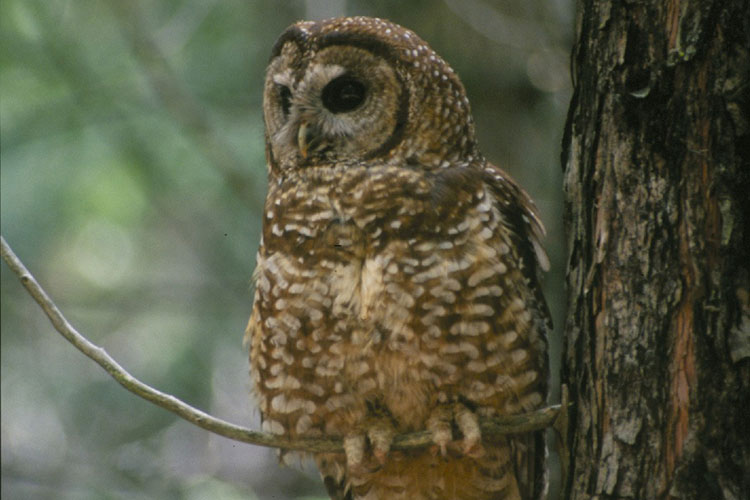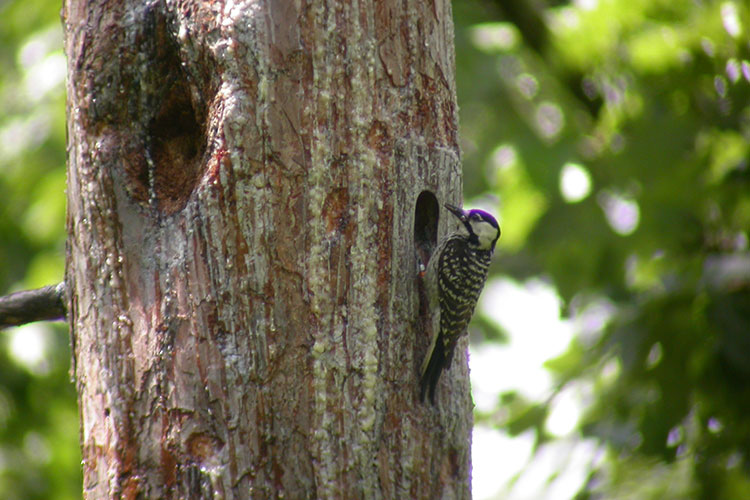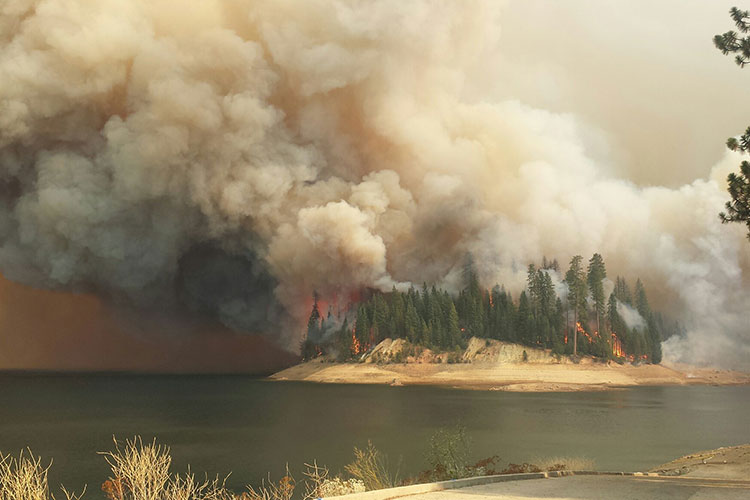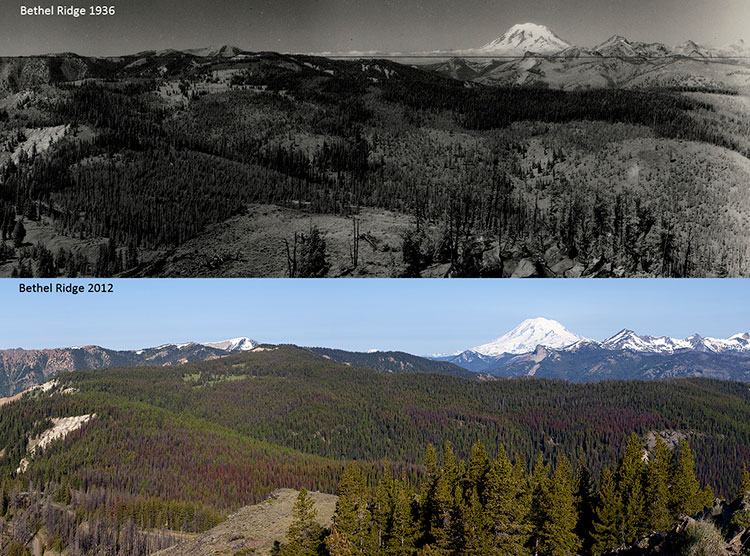Reposted from UC Berkeley News

Spotted owls, native to the old-growth forests of the West Coast, have already lost much of their former habitat to logging. Without active forest management, the birds now risk losing even more of their remaining habitat to wildfire, a new paper argues. (Photo by Tom Munton)
Spotted owl populations are in decline all along the West Coast, and as climate change increases the risk of large and destructive wildfires in the region, these iconic animals face the real threat of losing even more of their forest habitat.
Rather than attempting to preserve the owl's remaining habitat exactly as is, wildfire management — through prescribed burning and restoration thinning — could help save the species, argues a new paper by fire ecologists and wildlife biologists and appearing today (July 2 ) in the journal, Frontiers in Ecology and the Environment.
The paper compares the plight of the owl with that of another iconic threatened species, the red-cockaded woodpecker, which has made significant comebacks in recent years — thanks, in part, to active forest management in the southern pine forests that the woodpecker calls home. Though the habitat needs of the two birds are different, both occupy forests that once harbored frequent blazes before fire suppression became the norm.
“In the South, the Endangered Species Act has been used as a vehicle to empower forest restoration through prescribed burning and restoration thinning, and the outcome for the red-cockaded woodpecker has been positive and enduring,” said Scott Stephens, a professor of environmental science, policy and management at the University of California, Berkeley, and lead author on the study.
“In the West, it's just totally the opposite,” Stephens added. “Even though both places physically have strong connections to frequent fire, the feeling here is that the best thing to do is to try to protect what we have and not allow the return of frequent fire — but that's really difficult when you have unbridled fires just ripping through the landscape.”

The red-cockaded woodpecker, native to the Southeastern U.S., has benefited from prescribed burning and restoration thinning of the pine stands where it makes its home. (Photo by Warren Montague)
A tale of two birds
Spotted owls make their homes in the dense forests of the Western and Southwestern U.S., feeding on flying squirrels and woodrats and nesting in broken-off treetops or tree hollows. Red-cockaded woodpeckers, meanwhile, reside in pine stands in the Southeastern U.S., provisioning nests from nest boxes or hollowed-out cavities in living pine trees and eating insects pried from under tree bark.
Development and logging have robbed both species of much of their former habitat, and their populations have both taken a hit: Partners in Flight estimates the global breeding population of spotted owls to be at 15,000 individuals.
What habitat remains is now largely protected under the Endangered Species Act — but when it comes to fire and forest management, the act has been interpreted in dramatically different ways in the two regions, said paper co-author Leda Kobziar, associate clinical professor of wildland fire science at the University of Idaho.
“In the South, the act is interpreted to support active management through forest thinning and prescribed burning, and in the West, it is interpreted to exclude most fires and active management from protected areas surrounding spotted owl nests,” Kobziar said.
One critical difference is the degree to which active management in red-cockaded woodpecker habitat provides complementary benefits. “In the South, active management is known to reduce wildfire hazards, and it benefits local economies, along with a host of other fire-dependent species. In the West, those complementary benefits are less well-defined,” Kobziar said.
Another part of the reason for the discrepancy is perceived differences in the habitat preferences of the two birds, Kobziar explains. Red-cockaded woodpeckers live in more open, mature pine forests that result when low-intensity natural or prescribed burns limit the development of a forest midstory, where woodpecker predators take cover. Meanwhile, spotted owls generally prefer the dense, multi-layered forests that grow when fire is excluded.

The 2014 King Fire ripped through regions of Eldorado National Forest that had been home to a long-term study of the California spotted owl. (U.S. Forest Service photo via Flickr)
However, suppressing all fires in order to encourage growth of these dense canopies also creates conditions that are ripe for large, severe wildfires that can take out not just the smaller trees, but entire forests, obliterating swaths of owl habitat in the process. The 2014 King Fire, for example, tore through regions of the Eldorado National Forest that were home to a long-term study of the California spotted owl and caused the bird's largest population decline in the 23-year history of the study.
“A key question to be asking is: Where would owl habitats be with more characteristic fire regimes, and could we tailor landscape conditions where these habitats are less vulnerable and more supportive of today's wildfires?” said co-author Paul Hessburg, a research landscape ecologist with the U.S. Forest Service Pacific Northwest Research Station.
The solution would mean, “essentially creating less habitat in order to have more in the long run,” he said.
Fighting fire with fire
Before European settlement, many small- to medium-sized wildfires burned through the forests of the Southeastern and Western U.S., sparked by lightning or intentionally lit by native peoples to produce food, clear land or drive game. These fires would gobble up the dead wood, seedlings and saplings that made up the forest understory, while leaving taller, older trees standing and marked with fire scars recorded in their growth rings that fire ecologists use to track the frequency of historical fires.
In the mountainous landscape of the West, these fires didn't strike uniformly everywhere, to the potential benefit of the owls, Hessburg said. “If I took you back in the way-back machine 200 years ago, you would have seen that fire regimes in the Cascade Mountains differed very much by topographic setting,” he said. “Ridgetops and south slopes would often get pounded with lightning and fires, and so tree cover would be sparse. But in shaded and cool valley bottoms and north slopes, you would see complex layered forests, and some of these would have been incredible owl habitats.”

Bethel Ridge, located in central Washington State, photographed in 1936 (top) and again in 2012 (bottom). Decades of fire exclusion has allowed smaller, younger trees to flourish, making the forests considerably denser in contemporary times. (Top: National Archives photo; Bottom: Photo by John Marshall; both courtesy of Paul Hessburg)
Targeted restoration thinning and prescribed burning on ridgetops and dry southern slopes where fire used to be a frequent visitor, while leaving valley bottoms and northern slopes to develop into complex forest, could be a way to discourage large wildfires from ripping through vast landscapes, while maintaining owl habitat in a more fire-protected context.
New evidence also hints that owls may not be so dependent on dense understory canopies as once thought, the paper notes. Recent findings indicate that other aspects of forest structure, particularly the presence of large, old, tall trees, may be more important to the owls. These findings hint that prescribed burning and restoration thinning to reduce the size and severity of wildfires may not be damaging to owl habitat, even in the short term.
“We're treating the habitat as if we know precisely what habitat characteristics are preferred. It might be that these birds are tolerant of a broader range of characteristics that would enable things like fuels reduction to protect them from high-intensity wildfires,” Kobziar said.
“The South has melded fire and rare species management in a holistic way, but in the West, we're doing one or the other — (in) most places (where) we do forest restoration, we are trying to avoid owls,” Stephens said. “But the King Fire showed that owls and their habitats are vulnerable to large wildfires. More restoration thinning and prescribed burning could help us keep the habitat that we have now, modify it and actually make it more sustainable in the future.”
Other co-authors on the study include Brandon M. Collins of UC Berkeley; Raymond Davis, Joseph Ganey, James M. Guldin, Serra Hoagland, John J. Keane, Warren Montague, Malcolm North and Thomas A. Spies of the U.S. Forest Service; Peter Z. Fulé of Northern Arizona University; William Gaines of the Washington Conservation Science Institute; Kevin Hiers of the Tall Timbers Research Station; Ronald E. Masters of the University of Wisconsin-Stevens Point and Ann E. McKellar of Environment and Climate Change Canada.
RELATED INFORMATION
- Is fire ‘for the birds'? (Frontiers in Ecology and the Environment)
- Stephens Lab website